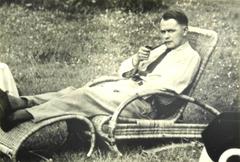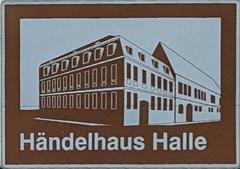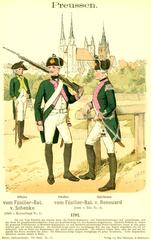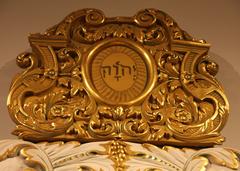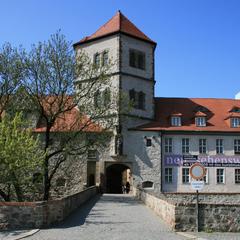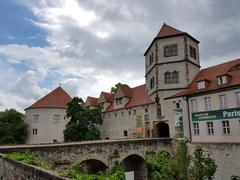
Hallors and Saline Museum Halle: Visiting Hours, Tickets, and Historical Sites Guide
Date: 04/07/2025
Introduction
The Hallors and Saline Museum (Halloren- und Salinemuseum) in Halle (Saale), Saxony-Anhalt, stands as a living testament to over 5,000 years of salt production. Set within the historic Royal Prussian Saltworks on Saline Island, the museum offers an immersive exploration of the economic, cultural, and technological legacy of salt—once known as “white gold”—and of the Halloren brotherhood, Germany’s oldest active salt workers’ guild. Visitors experience a blend of preserved industrial architecture, unique artifacts, live salt boiling demonstrations, and interactive exhibits that connect Halle’s deep past to its dynamic present (halle-touristinformation.de; salinemuseumhalle.de; halle365.de).
This guide covers everything you need to plan your visit, including up-to-date visiting hours, ticket info, accessibility, and the highlights of this essential Halle historical site.
Table of Contents
- Introduction
- Historical Significance of Salt in Halle
- Museum Architecture and Industrial Heritage
- Exhibition Highlights
- Visitor Information: Hours, Tickets, and Accessibility
- Special Events and Interactive Experiences
- Travel Tips and Nearby Attractions
- Cultural and Economic Importance
- Frequently Asked Questions (FAQ)
- Plan Your Visit and Stay Connected
- Conclusion
- References
Historical Significance of Salt in Halle
From Prehistoric Springs to Industrial Power
Salt production in Halle traces back over five millennia, rooted in the city’s unique geology. Natural brine springs formed from underground rock salt deposits, first exploited as early as 3000 BCE. Archaeological discoveries, including Bronze Age ceramics used for brine evaporation, underscore the region’s early salt expertise (fotoeins.com).
By the 8th century CE, systematic salt mining had begun beneath what is now Hallmarkt. The Halloren, whose name derives from the Celtic “hal” (salt), formed a respected community of salt workers. Their organization, traditions, and technical skills propelled Halle into the Hanseatic League by the 13th century, making it a key salt trading hub.
The Halloren Brotherhood
The Halloren brotherhood (“Salzwirker-Brüderschaft im Thale zu Halle”) remains one of Germany’s oldest professional guilds. Distinctive customs, ceremonial attire, and culinary specialties—like Soleier (brined eggs)—reflect their enduring cultural influence (fotoeins.com).
Industrialization and Transformation
In 1721, the Royal Prussian Saline was established on Saline Island, marking the shift to industrial-scale salt production. The integration of technical innovations, such as pan boiling and coal-fired steam engines, expanded output and shaped Halle’s industrial landscape (fotoeins.com). Salt production continued here until 1964, when the site was transformed into a museum, preserving both the architecture and living traditions of the Halloren.
Museum Architecture and Industrial Heritage
The Saline Island Complex
The museum is set amid a rare ensemble of industrial buildings spanning the 18th to early 20th centuries (wikipedia; halle-dreht-sich.de). Key structures include:
- Uhrenhaus (Clock House): The oldest building (1719–1721), a timber-framed salt magazine with a distinctive clock tower.
- Simmer Houses: Boiling halls dating from 1789 and 1833, where brine was transformed into salt using traditional methods.
- Salt Stores and Administration Buildings: These structures reflect the growth and technical evolution of the saline works, featuring both historic half-timbering and robust 19th-century construction.
- Pfännerschaftliche Kohlebahn: A narrow-gauge railway once transported coal from local mines to power the boiling pans (halle-dreht-sich.de).
Preservation and Modernization
Since 2020, the museum has been undergoing extensive renovations, funded by EU and state initiatives, to restore original features while introducing digital media and hands-on stations. The Großsiedehalle Süd (Large Boiling Hall South) is now open, offering a glimpse into the future of the museum (salinemuseumhalle.de; dubisthalle.de).
Exhibition Highlights
Core Themes
- Culture and History of Salt: From prehistoric wells and medieval brine pans to the industrial era, discover how salt shaped Halle’s economy, society, and urban fabric (halle365.de).
- The Halloren Brotherhood: See ceremonial silver treasures, historic garments, and learn about the rituals and social life of this unique guild (wiki-gateway.eudic.net).
- Industrial Heritage and Technology: Original boiling pans, conveyor belts, and coal railway relics illustrate the evolution of salt-making technology.
Interactive and Experiential Elements
- Live Salt Boiling Demonstrations: Witness traditional salt production using historic equipment—an engaging highlight for all ages (dubisthalle.de).
- Hands-On and Digital Experiences: Digital media, participatory exhibits, and hands-on stations make the science and history of salt accessible and fun (salinemuseumhalle.de).
- Special Collections: The Halloren’s ceremonial silver, salt-resistant plants in the museum garden, and rotating exhibitions on industrial heritage.
Visitor Information: Hours, Tickets, Accessibility
Opening Hours
- Regular Hours: Tuesday to Sunday, 10:00 AM – 5:00 PM. Closed Mondays and major public holidays.
- During Renovation: As of July 2025, the Großsiedehalle Süd is open Wednesday to Sunday, 10:00 AM – 5:00 PM. The full museum reopens by the end of 2025 (salinemuseumhalle.de).
Ticket Prices
- Adults: €8
- Reduced (students, seniors): €5
- Children under 6: Free
- Family and group discounts available
- Tickets can be purchased online or at the entrance
Accessibility
- Wheelchair accessible: ramps, elevators, and adapted restrooms are available
- Audio guides (multiple languages) and tactile exhibits for visually impaired visitors
- Contact the museum for tailored assistance
Special Events and Interactive Experiences
- Guided Tours: Available daily and in multiple languages. Advance booking recommended during peak times.
- Live Salt Boiling: Regular demonstrations on weekends and during special events.
- Workshops and Festivals: Participate in the annual Salzfest, Museum Night, and educational workshops for families and school groups.
- Community Engagement: Visitors can contribute ideas for future exhibits and participate in co-creation during special events (halle365.de).
Travel Tips and Nearby Attractions
- Location: Centrally situated on Salineinsel, near Halle’s historic Market Square.
- Public Transport: Accessible by tram and bus (lines 21 and 24), with stops at Hallmarkt. The main train station is a short tram ride or 25-minute walk away.
- Parking: Available nearby with clear signage.
- Nearby Halle Sites: Explore the Market Church, Halle Cathedral, Moritzburg Art Museum, and Händel House Museum—all within walking distance.
Cultural and Economic Importance
Preserving Heritage
The museum preserves the legacy of Halle’s salt production and the traditions of the Halloren, recognized by UNESCO as intangible cultural heritage (UNESCO Intangible Heritage). Its educational programs, workshops, and interactive exhibits foster historical awareness and community engagement (Museum Education Initiatives).
Economic Impact
As a top Halle historical site, the museum is a significant driver of cultural tourism, supporting local businesses, creating jobs, and enhancing the city’s international profile (Future Market Insights; City of Halle Tourism). Innovations in accessibility and digital engagement ensure continued relevance and sustainable growth (German Museums Association).
Frequently Asked Questions (FAQ)
Q: What are the museum’s opening hours?
A: Tuesday to Sunday, 10:00 AM–5:00 PM. See the official website for renovation-related updates.
Q: How much are tickets?
A: Adults €8, reduced €5, children under 6 free. Family and group rates are available.
Q: Is the museum accessible?
A: Yes. Ramps, elevators, and adapted toilets. Contact the museum for specific requirements.
Q: Are guided tours offered?
A: Yes, daily in several languages. Book in advance for groups.
Q: Can I see live salt-making demonstrations?
A: Yes, on weekends and during special events.
Q: Can I buy salt produced at the museum?
A: Salt is generally not sold due to regulations, but limited sales may occur during special events.
Q: Are photography and videography allowed?
A: Photography for personal use (no flash/tripods) is permitted.
Plan Your Visit and Stay Connected
- Official Information: salinemuseumhalle.de
- Visitor Support: Contact the museum for current accessibility, booking, or group visit inquiries.
- Stay Updated: Follow the museum on social media for news, exhibitions, and special event announcements.
- Enhance Your Visit: Download the Audiala app for digital guides and personalized tips.
Conclusion
The Hallors and Saline Museum is a cornerstone of Halle’s identity—an engaging, accessible, and evolving destination that brings the story of salt to life. Whether you are drawn by architectural heritage, living traditions, or hands-on learning, your visit supports the preservation of a unique industrial legacy and helps keep Halle’s vibrant cultural spirit alive.
Plan your visit today and experience the enduring legacy of “white gold” at one of Germany’s most remarkable industrial heritage sites.
References and Further Reading
- Technisches Halloren- und Salinemuseum: Visitor Information
- Salinemuseum Halle: Official Site
- Halle365: Event and Venue Portal
- Halloren.de: Saline Museum and Events
- Wikipedia: Hallors and Saline Museum
- Halle City Museums Portal
- Saltmaking History in Halle (fotoeins.com)
- The Crazy Tourist: Things to do in Halle
- Dubisthalle: Museum Renovation and Events
- UNESCO Intangible Heritage List
- Museum Education Initiatives
- City of Halle Cultural Heritage
- Future Market Insights: Museum Tourism
- German Museums Association



